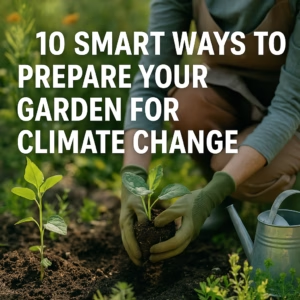As climate patterns continue to shift, gardeners are facing new challenges: hotter summers, unpredictable frosts, longer droughts, and heavier rains. It’s no longer enough to just water, weed, and wait. If you want a resilient, thriving space in the decades ahead, now is the time to prepare your garden for climate change.
Below are 10 simple, long-term strategies to help you adapt — and protect your little patch of the planet in the process.
1. Choose native and climate-resilient plants
Native plants are naturally adapted to your local conditions and require less water, fertilizer, and care. As weather extremes increase, these plants will be your most reliable allies. Consider native pollinators, drought-tolerant perennials, or old-growth tree saplings that provide shade and structure.

2. Use compost to build healthy, carbon-rich soil
Good soil is like a sponge — it absorbs water during downpours and holds moisture through dry spells. Adding compost improves drainage, boosts fertility, and helps trap carbon. Every shovel of compost makes your garden part of the climate solution.
3. Create shade zones
As temperatures rise, shade is essential. Prepare your garden for climate change by planting tall shrubs, installing trellises, or even placing reflective garden art. Shade reduces water evaporation, protects tender plants, and makes your garden more welcoming.
4. Harvest rainwater
Don’t let a drop go to waste. Install rain barrels or cisterns to collect water during storms and use it when your garden needs it most. It’s sustainable, cost-effective, and helps reduce runoff during heavy rain events — a win for you and your community.
5. Mulch like you mean it
Mulching keeps soil temperatures steady, reduces weeds, and locks in moisture. Use straw, wood chips, shredded leaves, or even grass clippings. It’s a natural, low-tech way to buffer your plants against climate stress.
6. Diversify your plantings
A garden of just one or two species is vulnerable to disease and pests. Biodiversity builds resilience. Mix edibles with flowers, trees with herbs, and natives with ornamentals. It’s not just beautiful — it’s smart ecology.
7. Use windbreaks to reduce plant stress
Strategically placed hedges, fences, or dense rows of trees can block strong winds that dry out soil and damage stems. Windbreaks make a huge difference as storm intensity increases with climate change.
8. Try no-dig gardening methods
Tilling the soil releases stored carbon and disrupts microbes that help your plants thrive. No-dig gardening keeps carbon in the ground, reduces weeds over time, and preserves soil structure. Less work, more impact.
9. Track microclimates in your yard
Even a small yard has variations: shady corners, sunny walls, low spots. Observe how frost settles or where water pools after rain. Use this info to place plants where they’ll naturally thrive — it’s free climate adaptation.
10. Get informed — and connected
The best gardeners aren’t just growing food or flowers. They’re growing knowledge. Climate change affects every region differently. Join local groups, read environmental newsletters, and stay up to date with science-backed advice.
🌱 Join the Movement: Protect More Than Just Your Garden
Learning how to prepare your garden for climate change is a powerful first step — but the challenges ahead go beyond our backyard fences. At The Tree Legacy Society, we work to protect forests permanently, ensuring climate resilience and biodiversity far beyond individual plots.
Want tips like these, delivered monthly — along with stories from communities protecting the planet in real ways?
Sign up to receive our newsletter
If you believe forest protection should be rooted in truth, not theory, consider supporting our work. Your donation helps us protect real trees, in real communities, for the long term. Together, we can build a legacy that counts — in more ways than one.
